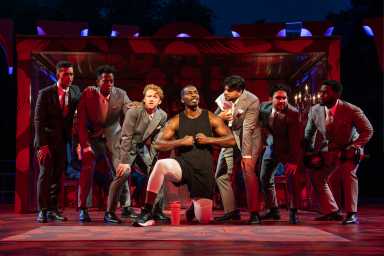Star-Packed Twelfth Night Reopens $85 Million Delacorte, Shakespeare in the Park Goes Big

Shakespeare in the Park’s luminous reboot at the Delacorte Theatre is both a tribute to New York’s cultural legacy and a test of whether free public arts can thrive amid urban transformation.
On a balmy June night, as fireflies blinked over Central Park’s newly polished walkways, New Yorkers queued as they have for generations: waiting, chatting, and clutching tickets to perhaps the city’s most egalitarian show. This year’s spectacle at the Delacorte Theatre—a gleaming, reimagined “Twelfth Night” featuring a constellation of stars—marked the reopening of a venue transformed by an $85 million renovation. If a gilded cast headlined by Lupita Nyong’o, Sandra Oh, and Peter Dinklage signaled anything, it was that Shakespeare in the Park intends to roar, not tiptoe, back onto the city’s cultural stage.
The news event itself is simple but weighty: after a yearlong hiatus, the Public Theater threw open the Delacorte’s doors for a July run of Shakespeare, tapping both nostalgia and novelty. Audiences were met with not merely a smartly restored theatre—its redwood exterior sleek, seats enlarged and accessible, the stage ripe for spectacle—but with a production palpably designed to announce the series’ primacy. The lure? Free tickets, a civic tradition stretching authoritatively back to Joseph Papp’s vision in 1962, but now turbocharged by marquee names and unapologetic theatricality.
For New York, this rebirth is more than architectural flourish or clever programming. Throughout its 62 summers, Shakespeare in the Park has perched at the strange intersection of high art and popular ritual—a rarefied experience on egalitarian terms. Attendance, once flagging under the weight of more obscure stagings, now looks buoyant: box-office lines stretch across the Ramble, and online lotteries pulse with renewed hope. The revamp’s emphasis on accessibility—broader aisles, ramps, expanded seats—matches the moment’s hunger for both inclusion and spectacle.
But the significance is not limited to Central Park’s leafy precincts. The Delacorte’s return portends broader ripples through the city’s civic life, economy, and self-conception. For one, the festival remains a bellwether of post-pandemic cultural appetite. After a punishing period for live performance—Broadway shuttered for eighteen dark months, freelance artists sidelined—its full-throated comeback presents a rare, public counterexample to the narrative of arts-industry decline. Star-driven productions, often seen as a marketing crutch, may provide necessary ballast for nonprofit institutions still regaining financial footing.
Second, the theatre’s rebirth acts as a litmus test for the city’s public realm. Free admission, in a metropolis where even breathing seems metered, is no small thing. Shakespeare in the Park depends not only on corporate donors and city largesse (the renovation drew from private philanthropy and public coffers alike), but also on the tacit social contract that art, when shared, can briefly unite the haughty banker, groggy shift worker, and restless student on a midsummer lawn. Whether that contract endures—amid rents, jostling for resources, and shifting city priorities—remains to be seen.
The economic impact is not paltry. A 2019 study by the Public Theater estimated that Shakespeare in the Park pumps $35 million annually into the local economy, funnelling business to restaurants and boosting tourism, with some visitors journeying from overseas. The lure of famous faces amplifies this effect; the economic calculus of celebrity is, on this evidence, decidedly rational. Cultural institutions citywide pay attention, discerning that high-wattage casting may be the difference between fiscal anaemia and survival.
Of course, New York’s anxieties about the price of culture are far from unique. From London’s Globe to the open-air theatres of Berlin, cities have grappled with how to square public access, fiscal reality, and artistic ambition. Few manage to offer high production values and free entry at the Delacorte’s scale. In Britain, public subsidy for the arts is embattled; in America, it was always tepid, and philanthropy fills the breach. But even an $85 million capital injection cannot insulate traditions from shifting demographics or creeping commercialisation.
Globally, the stakes are growing. As urban elites fret over declining audiences and digital distraction, New York’s experiment assumes a broader resonance. Will a city’s cultural institutions double down on inclusion and public space, or cede ground to paywalled exclusivity? The Delacorte has chosen the former path, betting that nostalgia, spectacle, and a dose of celebrity can rekindle the city’s flagging common life.
A raucous revival, a subtle wager
There is, of course, no guarantee of success. Star casting may goose attendance, but it courts fickleness; celebrity, by nature, is a perishable asset. A drag-ball curtain call and glowing “WHAT YOU WILL” set pieces amuse, but risks of trivialisation and artistic dilution linger. For every delighted family on the Great Lawn, there is a Shakespeare purist muttering about “brash modernity” and “lost subtlety”—but such grumbling is neither new nor uniformly relevant.
What does endure, and what this restoration has shrewdly recognised, is the city’s appetite for rituals that are both shared and unpriced. As government support for arts withers and inequality bites, the idea that great theatre should be a public good carries subversive weight. That the producers chose “Twelfth Night”—a paean to love, confusion, and mistaken identity—bodes well: in an age of polarization, its ambiguities are apt company.
Yet the Delacorte’s relaunch also highlights the fragility of these civic undertakings. Cultural capital, unlike real estate, can dissipate rapidly; a single season’s missteps, or a downturn in philanthropy, would matter. Still, if New York is to reckon with its present uncertainties, it will need precisely this mix of audacity and nostalgia, risk and renewal, that the Public Theater now displays.
In sum, while the new Delacorte does not—cannot—guarantee a renaissance for New York’s straining creative sector, it offers something both reassuring and hard-nosed: proof that a city inclined to wall itself off can, at least for a few weeks each summer, still find a common language in the open air. If that is not quite a midsummer night’s miracle, it remains a tradition worth queueing for. ■
Based on reporting from amNewYork; additional analysis and context by Borough Brief.